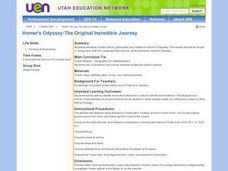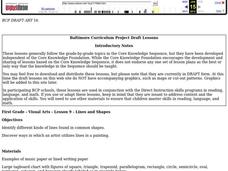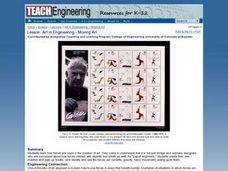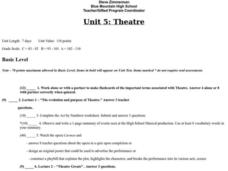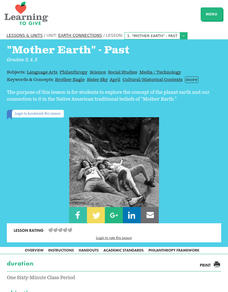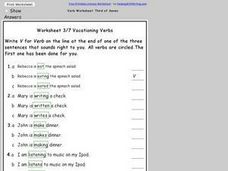Curated OER
Homer's Odyssey:The Original Incredible Journey
Young scholars study Greek culture, particularly as it relates to Homer's Odyssey. They examine how human activities shape the earth's surface and identify forces that influence a culture's beliefs and traditions. They determine that...
Curated OER
Hearing Conservation
Fourth graders identify and explain three methods of hearing conservation, identify three causes of hearing loss and identify four sounds that are dangerous to be exposed to for an extended period of time.
Curated OER
Jammin' to Jazz
Students identify integral parts of jazz music by listening to Quincy Jones' We Be Doin' It. They note the bass and drum sounds, scat solos, and also sing parts of the ostinato and chorus.
Curated OER
Understanding Simple Present Tense Verbs Using the Song 'Penny Lane"
In this music and grammar worksheet, students use the song, "Penny Lane" by the Beatles, to examine the use of simple present tense verbs. They listen to the song before completing 4 short answer questions. They record present tense...
Curated OER
Using Rock to Teach Literary Devices: Jimi Hendrix “The Wind Cries Mary”
Students explore literary elements through music. In this figurative language lesson, students examine imagery and personification in "The Wind Cries Mary" by Jimi Hendrix.
Curated OER
Fable for Tomorrow and Today -- Rachel Carson's Silent Spring
High schoolers read Rachel Carson's "Silent Spring". They identify their beliefs about the environment while reading the story. They discuss and write about those beliefs and realize how one person can have an impact on the world.
Curated OER
Lines and Shapes
First graders identify different kinds of lines found in common shapes. They discover ways in which an artist utilizes lines in a painting.
Curated OER
Government Agencies
Students are taught that there is more to executive branch of the federal government than the president and cabinet. They identify in pairs the names and fucntions of different departments under the executive branch of federal...
Curated OER
Now's the Time, Charlie Parker Now's the Time, Eddie Jefferson
Students delve into the music of bebop style jazz and the life and talents of some of the great musicians. The styles of Charlie Parker and James Moody are compared and contrasted in this instructional activity.
Curated OER
Native Americans During the 19th and 20th Centuries
Students explore major events in Native American history in the nineteenth and twentieth centuries. In this American history lesson plan, students listen to lectures, examine photographs, and analyze music regarding Native American...
Curated OER
Creating Community - A Function Of Design
High schoolers discuss the physical and human impacts of community design. They identify traditional neighborhood design elements and evaluate them with features of conventional suburban development.
Curated OER
Art in Engineering - Moving Art
Students study how forces are applied in the creation of art. They design mobiles and pop-up books while identifying which forces of nature act upon them. They look at air currents, gravity, and hand movement.
Curated OER
Theatre
Students identify and create flashcards of important key terms as related to theatre. Students observe and write a 1-page summary of events seen at the High School Musical production using at least 8 vocabulary words in your summary....
Curated OER
Teaching With the Power of Objects
Students define value of an object. In this value lesson plan, students identify reasons for collecting objects, compile a personal inventory of items they find valuable, and then define why those items are valuable to them. In step two...
Curated OER
Oh, Say Can You See...
Young scholars explore the meaning behind "The Star-Spangled Banner." In this music lesson, students sing the first verse of the national anthem and watch several performances of "The Star-Spangled Banner." Young scholars define several...
Curated OER
"Mother Earth" -- Past
Students examine our connection to the Earth. They identify how Native Americans believed in a "Mother Earth". They discover how the earth and life are connected.
Curated OER
Lesson One: Characterizing Philanthropic People
Familiarize your class with philanthropy and involve individuals in philanthropic activities. First, determine the traits of philanthropic people. Class members attach sticky notes with character traits written on them to each side of at...
Curated OER
The Ballad of the Sad Café
Students view the film "The Ballad of the Sad Cafe" and analyze it for stereotypes of mountain and hillbilly communities. They identify and discuss Appalachian values represented in the film and write a report on their observations.
Curated OER
Treacherous Trash
Learners recognize the harmful effects people have on the environment. For this environmental lesson, students simulate water pollution clean-up by using tangled objects and untangling them in a cooperative group. Learners identify why...
Curated OER
Traditions of Tribal Sharing
Learners examine the idea of tribal sharing in the Native American community. They read a story about Native Americans and note the ways they are helping others. They draw a picture showing one of these acts.
Curated OER
To Be Or Not To Be a State? That Is the Question
Eighth graders research Puerto Rico's culture, religion, language, government, etc. and identify differences and similarities with the United States. They participate in a debate about whether or not Puerto Rico should become a state.
Curated OER
Health, Decision Making, Research, Media Literacy
Young scholars explore the problem of bullying. They observe an anti-bullying commercial and discuss how a victim may feel. After a class discussion, students identify tools a victim may use to get away from a bully and obtain...
Curated OER
Harder Homonyms
In these homonyms worksheets, students complete two different word search puzzles that give clues and the words to help them identify homonyms.
Curated OER
Worksheet 3/7 on Verbs
In this recognizing verb usage in sentences worksheet, students read groups of three sentences with the same subject and predicate but different verbs and identify the sentence that uses the verb correctly. Students write 7 answers.


